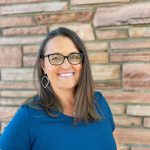Lindsey Marlow
Steamboat Springs, Colorado
This interview was conducted by Brian Murphy on October 31, 2022. Learn more about Lindsey’s work at https://friendsoftheyampa.com/.
Transcript
Tell me about Friends of the Yampa and your role as the Executive Director?
Friends of the Yampa (FOTY) has been around since the 1980s, originally as a group of boaters who cared about the river and were pushing recreational interests as well as our annual River Fest. It changed over time and included more environmental interests in the mission in 2018. Currently, our mission is to ensure the environmental and recreational integrity of the Yampa River through outreach, education, advocacy, and partnerships. We do everything from youth river camps to scientific studies to advocacy and we’ve been trying to expand our reach since I started 3 years ago. I was the only staff member and we currently have 5 staff members.
Can you give me a few examples of the impact FOTY has, is having, or will have in the Yampa Basin? What’s the vision going forward?
One thing we’ve always done well is the people. Bringing science and concern and stewardship into the river and this community and getting people to show up and listen. One thing we’re branching into now is facilitating projects. Before we were facilitating partnerships or pushing things forward. Now we’re trying to put more teeth behind our work by moving projects forward ourselves. There is so much work that needs to be done on the Yampa and there hasn’t been, until recently, a group to step up to the plate. This involves everything from our Yampa River Scorecard project, which is a long-term monitoring project, to taking on river restoration and protection projects. Let’s save the places that are already healthy and maintain the Yampa as the unique asset that it is. We are fortunate to be tackling the issue of protection more so than restoration, but our biggest task is getting people to care before something bad happens. People tend to be reactionary instead of prevention focused.
You mentioned the Yampa River Scorecard. Can you expand on that long-term river health monitoring and evaluation program for the Yampa Basin? How does FOTY envision using this program to support river health in the Yampa Basin?
That’s a deep question! I’ve thought about all the benefits and ways this project connects to others but it’s easy to sell it short because it’s so widely useful and applicable. The foundation of the project is the river health assessments happening through stream management plans in Colorado. The Scorecard is taking it one step further and not just measuring the ecological health and function of the river but how we use the river and how it benefits the communities. We need to tell a story and explain how a healthy river benefits everyone and, in order to do that, we need to know how we use the river including agriculture, recreation, ecosystem services, and community health. It’s kind of an annual report on how the entire basin is doing. It will also ensure that we’re on the right track with the integrated water management process.
Tell me about the partnership with Colorado Mountain College students and how these students have been brought into the Scorecard project?
There’s a lot of energy and excitement around the Score Card project and one of our goals was to give the Basin as much benefit as possible. We thought it would be important to use this as a professional development tool to get people out in the field and collect this meaningful, usable data, so we developed a field class with CMC where we take students out onto the Yampa. We also partner with the CMC for our youth river camps. We do the registration, outreach, and curriculum development and they hire the staff and execute the camps.
You talked about the preservation aspect of your work. Is that part of the Scorecard as well, identifying areas for conservation?
The Scorecard is less about highlighting what we’re doing wrong and more about highlighting the areas in the Yampa Basin that are doing great and need further protection. Say a river segment gets a B+, that is an area we should preserve as much as possible and set aspirational protection goals. To me, the grades aren’t to point fingers, they’re to show focus and prioritize based on need.
How is the agricultural community brought into your work? Is it through these events or more specialized partnerships and relationships?
We do most of our engagement in stakeholder groups and one-on-ones. In fact, our one-on-ones have increased a lot through the Scorecard effort. We’ve been reaching out to landowners to get access and explain how this effort benefits them and how they can add to it. We’ve been building these relationships through that, also through our partnership organizations like Community Agriculture Alliance. We did a recreational stakeholder survey during the integrated water management planning process, and we asked what they thought of the ag community in this basin and the majority responses were very positive. The communities do attribute our pastoral landscapes and very untouched basin to agriculture, so there’s a respect and connection there.
Who supports FOTY and why is their investment so critical to the Yampa River Basin?
50-60% of the organization is supported by grants, which is significant, but we do get a large amount of individual donation and foundation grants that go to general operating funds. There’s a lot of trust out there and that’s what’s needed. We’re still a small group, and small groups like ours can make a dollar go a long way, but we do need to be able to adapt and move with the times. Really those individual donations are how we’ll be able to grow.
FOTY recently took over running the Yampa River Fund. What has that meant for you?
The Nature Conservancy starting the Yampa River Fund, the first in the United States, was a big deal! When I started this position, it was mentioned that the River Fund would be looking for a new nonprofit to take over and we wanted to be that organization. We strived to get to a point where we were a trusted group, and we ultimately achieved that goal. For a small organization to hold and operate an endowment fund that large is pretty significant.
Tell me about your special events and how FOTY engages the local community to support a healthy Yampa River?
My little tagline for recreation is that it’s a gateway drug to the environment. Our signature event is the Yampa River Festival, which is not a huge fundraiser but brings people to the river to just have fun. We have tubing for those who aren’t skilled boaters. It’s actually the most fun for the observers. It brings them to the river for a positive, feel-good experience that makes people love the river. We get a ton of people who don’t do any river recreation, but they come to the festival. This is an accepting community, one of the few outdoor communities that is super open and loving toward new people. That’s what we seek to do. It’s free with really low cost for specific events. For many, this is the first experience they get before they start opening their eyes to a better environment.
About
Lindsey comes from an environmental and hydrology background and with her eclectic mix of experience and education, brings an environmental vigor that is an asset to the Friends of the Yampa. She has experience with environmental policy and response as an environmental regulator through the US Coast Guard (in which she is still in the Reserves) including environmental outreach and stream surveying, studies in hydrology, ecology, environmental science, outdoor education and administration, as well as film and media relations. Lindsey enjoys a variety of outdoor activities and just being in the elements. Lindsey grew up playing in the Colorado River and developed a preference for inland waters despite growing in San Diego. She has focused her life on environmental stewardship and immersion and is excited to be a voice for the Yampa River.







